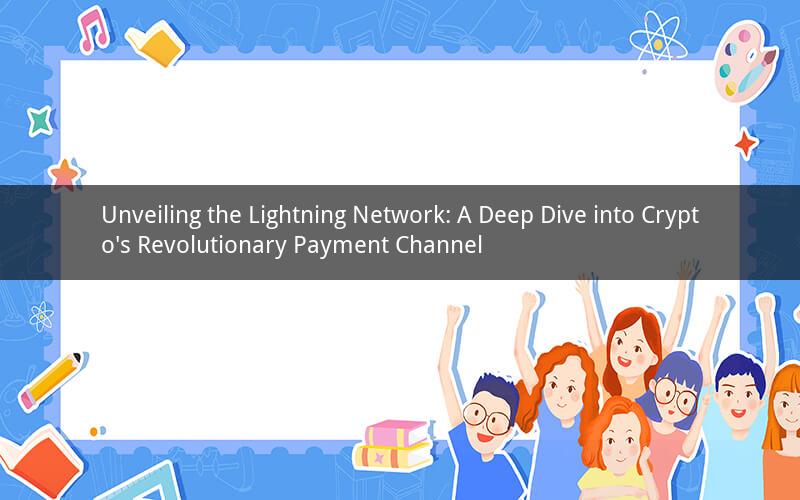
The Lightning Network, a groundbreaking innovation in the crypto world, has sparked intense interest among enthusiasts and investors alike. What is the Lightning Network, and how does it reshape the crypto landscape? This article delves into the intricacies of the Lightning Network, exploring its features, benefits, and potential impact on the future of cryptocurrency transactions.
What is the Lightning Network?
The Lightning Network is a second-layer payment protocol built on top of the Bitcoin blockchain. It enables instant, low-cost transactions between participants, without the need for confirmation from the underlying blockchain. The network achieves this by creating payment channels between two parties, allowing them to send and receive payments directly without relying on the blockchain.
How does the Lightning Network work?
The Lightning Network operates by establishing payment channels between two parties. These channels are created by locking a certain amount of Bitcoin into a multi-signature wallet controlled by both parties. Once the channel is established, the parties can send and receive payments instantly, with the settlement occurring off-chain.
Here's a simplified explanation of how the Lightning Network works:
1. Alice and Bob create a payment channel by locking a certain amount of Bitcoin into a multi-signature wallet.
2. Alice and Bob can now send and receive payments to each other instantly, without relying on the blockchain.
3. When Alice and Bob wish to close the channel, they can settle the outstanding balance by broadcasting a transaction to the blockchain, which releases the locked Bitcoin.
Benefits of the Lightning Network
The Lightning Network offers several benefits over traditional blockchain transactions:
1. Instant transactions: The Lightning Network allows for near-instant transactions, with confirmation times measured in seconds, as opposed to minutes or hours for traditional blockchain transactions.
2. Low fees: Transactions on the Lightning Network are significantly cheaper than those on the Bitcoin blockchain, making it more cost-effective for users.
3. Scalability: The Lightning Network addresses the scalability issues of the Bitcoin blockchain by offloading transactions to the second layer, thereby reducing the load on the main chain.
4. Privacy: Transactions on the Lightning Network are private, as they do not involve the underlying blockchain. This enhances user privacy and security.
Challenges and limitations
Despite its numerous benefits, the Lightning Network faces several challenges and limitations:
1. Interoperability: The current state of the Lightning Network is fragmented, with different implementations and channels that are not interoperable. This hinders the network's growth and adoption.
2. Centralization: The Lightning Network relies on a centralized node network, which raises concerns about security and reliability.
3. Scalability: While the Lightning Network aims to improve scalability, it still faces limitations in terms of the number of payment channels that can be created simultaneously.
4. Adoption: The Lightning Network's adoption remains relatively low, with only a fraction of the total Bitcoin transactions occurring on the network.
The future of the Lightning Network
The Lightning Network has the potential to revolutionize the crypto landscape by enabling instant, low-cost transactions. However, the network's success depends on overcoming its current challenges and limitations.
1. Interoperability: Efforts are being made to create a more interoperable Lightning Network, with projects like the Interledger Protocol (ILP) aiming to connect different implementations.
2. Decentralization: The community is working on ways to decentralize the node network, thereby enhancing security and reliability.
3. Scalability: Further research and development are needed to address scalability issues and increase the number of payment channels that can be created simultaneously.
4. Adoption: The Lightning Network's adoption will likely increase as more users and businesses recognize its benefits and start using it for transactions.
Frequently asked questions about the Lightning Network
1. What is the purpose of the Lightning Network?
The Lightning Network's purpose is to enable instant, low-cost transactions between participants, without the need for confirmation from the underlying blockchain.
2. How does the Lightning Network differ from the Bitcoin blockchain?
The Lightning Network operates as a second layer on top of the Bitcoin blockchain, allowing for instant transactions off-chain, while the Bitcoin blockchain handles the settlement of transactions.
3. Can the Lightning Network handle large-scale transactions?
The Lightning Network has the potential to handle large-scale transactions, but its current scalability remains a challenge. Ongoing research and development aim to improve the network's capacity.
4. Is the Lightning Network secure?
The Lightning Network is generally secure, but it relies on a centralized node network, which raises concerns about security and reliability. Efforts are being made to decentralize the network and enhance its security.
5. How can I use the Lightning Network for transactions?
To use the Lightning Network for transactions, you need a compatible wallet and a payment channel with another participant. You can then send and receive payments instantly without relying on the underlying blockchain.